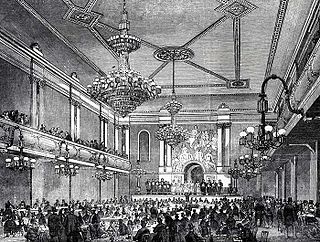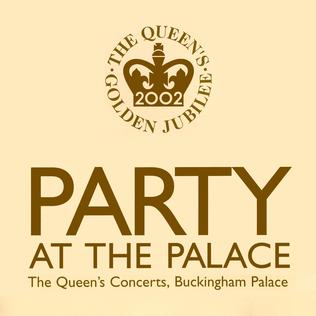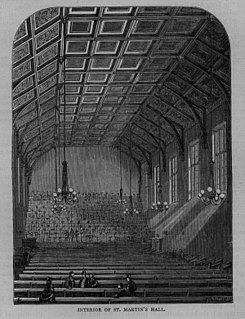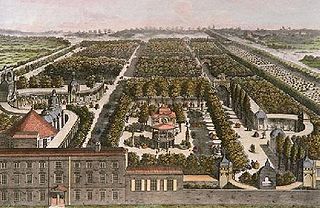 W
WAlmack's was the name of a number of establishments and social clubs in London between the 18th and 20th centuries. Two of the social clubs would go on to fame as Brooks's and Boodle's. Almack's most famous establishment was based in assembly rooms on King Street, St James's, and was one of a limited number of upper class mixed-sex public social venues in the British capital in an era when the most important venues for the hectic social season were the grand houses of the aristocracy. The site of the club, Almack's Assembly Rooms or Willis's Rooms, has become retrospectively interchangeable with the club, though for much of the club's lifetime, the rooms offered a variety of other entertainments with no connection to the club.
 W
WAstley's Amphitheatre was a performance venue in London opened by Philip Astley in 1773, considered the first modern circus ring. It was burned and rebuilt several times, and went through many owners and managers. Despite no trace of the theatre remaining today, a memorial plaque was unveiled in 1951 at its site at 225 Westminster Bridge Road.
 W
WThe Bartholomew Fair was one of London's pre-eminent summer Charter fairs. A charter for the fair was granted to Rahere by Henry I to fund the Priory of St Bartholomew; and from 1133 to 1855 it took place each year on 24 August within the precincts of the Priory at West Smithfield, outside Aldersgate of the City of London. The fair continued, after the Dissolution within the Liberty of the parish of St Bartholomew-the-Great.
 W
WBanksy is a pseudonymous England-based street artist, political activist, and film director whose real name and identity remain unconfirmed and the subject of speculation. Active since the 1990s, his satirical street art and subversive epigrams combine dark humour with graffiti executed in a distinctive stenciling technique. His works of political and social commentary have appeared on streets, walls, and bridges throughout the world. Banksy's work grew out of the Bristol underground scene, which involved collaborations between artists and musicians. Banksy says that he was inspired by 3D, a graffiti artist and founding member of the musical group Massive Attack.
 W
WThe Canterbury Music Hall was established in 1852 by Charles Morton on the site of a former skittle alley adjacent to the Canterbury Tavern at 143 Westminster Bridge Road, Lambeth. It was one of the first purpose-built music halls in London, and "probably the largest and grandest concert-room ever attached to a public house" in London. Morton came to be dubbed the Father of the Halls as hundreds of imitators were built within the next several years. The theatre was rebuilt three times, and the last theatre on the site was destroyed by bombing in 1942.
 W
WChelsea Theatre is a studio theatre located on the Kings Road in the Royal Borough of Kensington and Chelsea, London. It presents, commissions, and produces material and works with the local community.
 W
WCremorne Gardens were popular pleasure gardens by the side of the River Thames in Chelsea, London. They lay between Chelsea Harbour and the end of the King's Road and flourished between 1845 and 1877; today only a vestige survives, on the river at the southern end of Cheyne Walk. Cremorne is also a ward of the Royal Borough of Kensington and Chelsea. The population of the ward at the 2011 Census was 7,974.
 W
WCuper's Gardens were 17–18th century pleasure gardens on the south side of the River Thames in Lambeth, London. The gardens looked over to Somerset House near Waterloo Bridge, and were centered on what is now the north end of Waterloo Road.
 W
WThe Diamond Jubilee Concert was a British music concert and celebration held outside Buckingham Palace on The Mall in London on 4 June 2012. The concert was organised by Take That singer-songwriter Gary Barlow and was part of Queen Elizabeth II's Diamond Jubilee celebrations.
 W
WThe Exeter Exchange was a building on the north side of the Strand in London, with an arcade extending partway across the carriageway. It is most famous for the menagerie that occupied its upper floors for over fifty years, from 1773 until the building was demolished in 1829.
 W
WThe Finborough Theatre is a fifty-seat theatre in the West Brompton area of London under artistic directorship of Neil McPherson. The theatre presents new British writing, as well as UK and world premieres of new plays primarily from the English speaking world including North America, Canada, Ireland, and Scotland including work in the Scots language, alongside rarely seen rediscovered 19th and 20th century plays. The venue also presents new and rediscovered music theatre.
 W
WThe Leverian collection was a natural history and ethnographic collection assembled by Ashton Lever. It was noted in particular for the content it acquired from the voyages of Captain James Cook. For three decades it was on display in London, being broken up by auction in 1806.
 W
WOxford Music Hall was a music hall located in Westminster, London at the corner of Oxford Street and Tottenham Court Road. It was established on the site of a former public house, the Boar and Castle, by Charles Morton, in 1861. In 1917 the music hall was converted into a legitimate theatre, and in 1921 it was renamed the New Oxford Theatre. In May 1926 it closed and was demolished.
 W
WThe Pantheon was a place of public entertainment on the south side of Oxford Street, London, England. It was designed by James Wyatt and opened in 1772. The main rotunda was one of the largest rooms built in England up to that time and had a central dome somewhat reminiscent of the celebrated Pantheon in Rome. It was built as a set of winter assembly rooms and later briefly converted into a theatre. Before being demolished in 1937, it was a bazaar and a wine merchant's show room for over a hundred years. Marks and Spencer's "Oxford Street Pantheon" branch, at 173 Oxford Street now occupies the site.
 W
WThe Party at the Palace was a British pop/rock music concert held in London in 2002. The event was in commemoration of the Golden Jubilee of Queen Elizabeth II held over the Golden Jubilee Weekend 1–4 June 2002. The event itself was held at Buckingham Palace Garden on 3 June 2002. It was the pop/rock equivalent of the Prom at the Palace, that showcased classical music.
 W
WThe Queen's Birthday Party was a music concert held at the Royal Albert Hall in London on 21 April 2018 to celebrate the 92nd birthday of Queen Elizabeth II. Organised by the Royal Commonwealth Society, the event coincided with the end of the 2018 Commonwealth Heads of Government Meeting, which had taken place in the United Kingdom during the previous week. The concert was presented by radio and television presenter Zoë Ball and featured contemporary artists, as well as those from the worlds of classical music and jazz, all of whom are from countries that belong to the Commonwealth of Nations. Artists included Tom Jones, Kylie Minogue, Sting, Shaggy, Shawn Mendes, Anne-Marie, The George Formby Society and Ladysmith Black Mambazo. Many of those who took part in the concert were accompanied by the BBC Concert Orchestra. The Queen was among concert attendees, along with other members of the Royal family. The concert was broadcast on BBC One and BBC Radio 2 in the UK and the Nine Network in Australia.
 W
WThe Queen's Theatre in London was established in 1867 as a theatre on the site of St Martin's Hall, a large concert room that had opened in 1850. It stood on the corner of Long Acre and Endell Street, with entrances in Wilson Street and Long Acre. The site is within the modern Camden, part of Covent Garden.
 W
WRanelagh Gardens were public pleasure gardens located in Chelsea, then just outside London, England in the 18th century.
 W
WThe Restoration spectacular, also known as a machine play, was a type of theatre prevalent in the late 17th-century Restoration period. Spectaculars were elaborately staged, comprising such setups as action, music, dance, moveable scenery, baroque illusionistic painting, costumes, trapdoor tricks, "flying" actors, and fireworks. Although they were popular with contemporary audiences, spectaculars have endured a bad reputation as a vulgar contrast to the witty Restoration drama.
 W
WRoyal Surrey Gardens were pleasure gardens in Newington, Surrey, London in the Victorian period, slightly east of The Oval. The gardens occupied about 15 acres (6.1 ha) to the east side of Kennington Park Road, including a lake of about 3 acres (1.2 ha). It was the site of Surrey Zoological Gardens and Surrey Music Hall.
 W
WVauxhall Gardens is a public park in Kennington, London, England, on the south bank of the River Thames.
 W
WVenice in London was a spectacular held at Olympia in London from 26 December 1891 to January 1893. It was also variously described as Venice The Bride of the Sea at Olympia, Venice at Olympia, etc.
 W
WThe Windmill Theatre — now The Windmill International — in Great Windmill Street, London was for many years both a variety and revue theatre. The Windmill remains best known for its nude tableaux vivants, which began in 1932 and lasted until its reversion to a cinema in 1964. Many prominent British comedians of the post-war years started their careers working at this theatre.